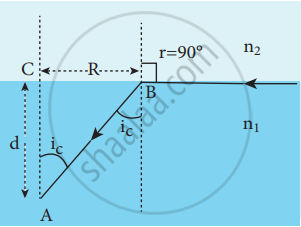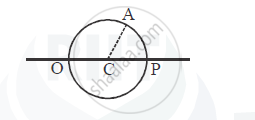Advertisements
Advertisements
Question
Obtain the equation for radius of illumination (or) Snell’s window.
Solution
- When light entering the water from outside is seen from inside the water, the view is restricted to a particular angle equal to the critical angle ic.
- This restricted illuminated circular area is called Snell’s window.
- The angle of view for water animals is restricted to twice the critical angle 2ic. The critical angle for water is 48.6°. The angle of view is 97.2°.
- The radius R of the circular area depends on the depth d from which it is seen and the refractive indices of the media.
- Light is seen from a point A at a depth d.
Snell’s law
n1 sin ic = n2 sin 90°
n1 sin ic = n2 ∵ sin 90° = 1
sin ic = `"n"_2/"n"_1` - From the Right angle triangle ∆ ABC,
sin ic = `"CB"/"AB" = "R"/sqrt("d"^2 + "R"^2)`
Equating the above two equations
`"R"/sqrt("d"^2 + "R"^2) = ("n"_2/"n"_1)`

Radius of Snell’s window
Squaring on both sides,
`"R"^2/("R"^2 + "d"^2) = ("n"_2/"n"_1)^2`
Taking reciprocal,
`("R"^2 + "d"^2)/"R"^2 = ("n"_1/"n"_2)^2`
On further simplifying,
`1 + "d"^2/"R"^2 = ("n"_1/"n"_2)^2; "d"^2/"R"^2 = ("n"_1/"n"_2)^2 - 1;`
`"d"^2/"R"^2 = ("n"_1^2/"n"_2^2) - 1 = ("n"_1^2 - "n"_2^2)/"n"_2^2`
Again taken reciprocal and rearranging
`"R"^2/"R"^2 = "n"_2^2/("n"_1^2 - "n"_2^2); "R"^2 = "d"^2("n"_2^2/("n"_1^2 - "n"_2^2))`
Tha radius of illumination is,
R = d`sqrt(("n"_2^2)/("n"_1^2 - "n"_2^2))`
If the rarer medium outside in air, then, n2 = 1, and we can take n1 = n
R = d`1/sqrt("n"^2 - 1)` (or) R = `"d"/sqrt("n"^2 - 1)`
APPEARS IN
RELATED QUESTIONS
A small pin fixed on a table top is viewed from above from a distance of 50 cm. By what distance would the pin appear to be raised if it is viewed from the same point through a 15 cm thick glass slab held parallel to the table? Refractive index of glass = 1.5. Does the answer depend on the location of the slab?
A diver under water, looks obliquely at a fisherman standing on the bank of a lake. Would the fisherman look taller or shorter to the diver than what he actually is?
Light incident normally on a plane mirror attached to a galvanometer coil retraces backward as shown in Figure. A current in the coil produces a deflection of 3.5° of the mirror. What is the displacement of the reflected spot of light on a screen placed 1.5 m away?

A pole of length 1.00 m stands half dipped in a swimming pool with water level 50.0 cm higher than the bed. The refractive index of water is 1.33 and sunlight is coming at an angle of 45° with the vertical. Find the length of the shadow of the pole on the bed.
A convex lens of focal length 20 cm and a concave lens of focal length 10 cm are placed 10 cm apart with their principal axes coinciding. A beam of light travelling parallel to the principal axis and having a beam diameter 5.0 mm, is incident on the combination. Show that the emergent beam is parallel to the incident one. Find the beam diameter of the emergent beam.
A point ‘O’ marked on the surface of a glass sphere of diameter 20 cm is viewed through glass from the position directly opposite to the point O. If the refractive index of the glass is 1.5, find the position of the image formed. Also, draw the ray diagram for the formation of the image.

Answer the following question.
Define absolute refractive index and relative refractive index. Explain in brief with an illustration for each.
What is a principle of reversibility?
Why do stars twinkle?
A ray of light passes through equilateral prism such that the angle of incidence is equal to angle of emergence and each of these angles is equal to `(3/4)^"th"` the angle of prism. The angle of deviation is ______.
